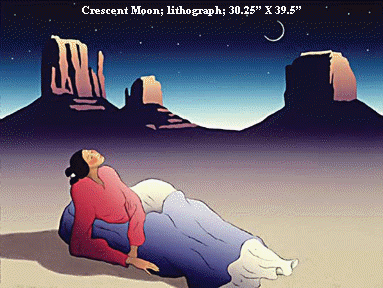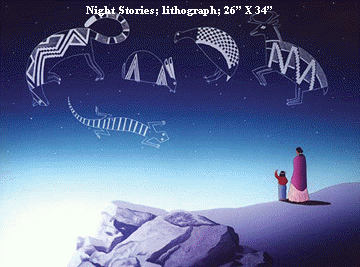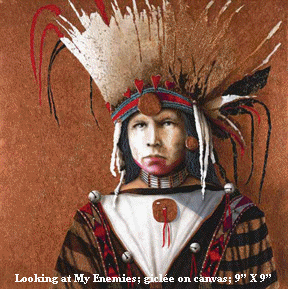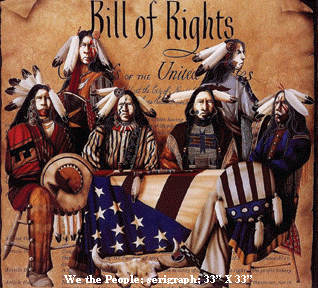Fall 2007, Volume 24.1
Essay
Larry Tritten
R. C. Gorman and J. D. Challenger: Two Hearts of the West
Larry Tritten is a veteran freelance writer of fiction, humor, and travel. His work has appeared in The New Yorker, Harper’s, Vanity Fair, Travel & Leisure, Rolling Stone, National Geographic Traveler, New York and L. A. Times. He lives in San Francisco.
When I was a kid growing up in the backwoods of North Idaho, the first art I was exposed to, long before the names Bosch, Van Gogh, Picasso, and Pollock were part of my vocabulary, was art whose subject was the American West. Remington and Russell were the masters of the genre and their pictures were everywhere—in bars, shops, banks, and gas stations. It was probably the same if you grew up in Texas or Arizona or South Dakota. The work of Remington and Russell reflected the provincial pride and narcissism of the West. And the work of local artists influenced by them was also ubiquitous—a superabundance of Western landscapes, cowboys and Indians, elk, deer, and buffalo, etc.
I remember being spellbound by my first sight of Cassilly Adams’ Custer’s Last Fight, the painting that appeared widely in American barrooms as a color lithograph distributed by the Anheuser Busch Brewing Association. This panoramic display of mayhem—countless Indians and cavalry men engaged in a melee of saber and tomahawk-swinging close combat—ravished my prepubescent imagination. I was also a fan of comic book art, most of which was third-rate, but there were a few artists who were superior craftsmen, among them John Severin whose Western stories were distinguished by the kind of authenticity found in paintings by Remington and Russell. If an Indian drawn by the average hack tended to look like someone in a Woolworth’s Halloween Indian costume, an Indian drawn by Severin was strikingly accurate. The Western stories drawn by Severin, and those in collaboration with Bill Elder, as well as their Civil War stories, helped stimulate my interest in American history and Western novels (especially those by Will Henry, who I found far superior to Louis L’Amour). And Severin brought verisimilitude to the land, too. His trees and rocks looked like real trees and rocks, not just amorphous blobs and squiggles, and his canyons and mountains and deserts had a photographic quality.
When I was still in grade school, my parents bought a tavern where we also lived. In those days there was a local artist, Joe Breckenridge, sort of a cross between Remington and Cézanne, who my Dad paid to paint Western scenery on the walls and booths. Watching him work, I was reminded of those scenes in Disney cartoons in which a paint brush would literally throw paint on a canvas and a fully formed scene would spontaneously appear. Using a brush, or even such a thing as an old sock, Joe would magically materialize Western scenery before one’s eyes. But he did take a little more time and care in painting on one of the booth tables, at my request, a pack horse in a snow storm. The Pine Creek Tavern is still there, but I was saddened to hear from a friend in Idaho that years ago the paintings were destroyed, painted over for some unknown reason.
As an adult, I’ve tended to favor abstract and nonobjective and surrealist art, but it was a recent trip to Taos that returned me to my roots, so to speak. There are over a hundred art galleries and museums in Taos and every kind of art is on display—at the Van Vechten-Lineberry museum I wandered into a room of stark white canvases that fairly bid to upstage Kasimir Malevich’s Suprematist Composition: White on White—but making an acquaintance with the work of R.C. Gorman and J. D. Challenger revived my long dormant appreciation of the art of the American West.
I was with a small group of writers who were invited to Gorman’s home (and studio) and Challenger’s studio. Gorman, a Navajo artist who has been described by The New York Times as "the Picasso of American Indian artists," has a style characterized by flamboyant use of color, and while some of his work has been surreal, much of it simply and quietly reflects his Navajo heritage. Gorman’s lifestyle has made him a controversial figure. As a young man, he was a nude model as well as an artist. He numbers a wide variety of celebrities among his friends, likes odd pets (iguanas, skunks, pigs), wears bright Hawaiian shirts and headbands, and drives a gold Mercedes. One of his passions is food, a topic that provides a hearty rhetorical buffet in the book Nudes and Foods: Gorman Goes Gourmet, tales compiled by Virginia Dooley. Gorman grew up eating prune sandwiches and living in a hogan, but today he has a cosmopolitan palate (no less than a cosmopolitan palette!) and his home is worthy of an Architectural Digest photo feature.
Gorman had lunch with us at Villa Fontana, a small, intimate restaurant where the paintings on the wall were done by the chef and owner, Carlo Gislimberti. Gorman, wearing the ever-present gaudy shirt and headband, was at the next table, but I observed that throughout lunch he was lively, friendly, and convivial.
From the restaurant we went to his home, which is a cornucopia of art, pieces in his collection as well as his own works, which run a spectrum through oil pastel drawings, lithographs, acrylics, silkscreens, bronzes, tapestries, cast paper, ceramics, and etched glass. With the aforementioned New York Times quote in mind, I noticed a real Picasso on one wall and several books on Picasso in rooms throughout the house. With my eye for the frivolous and offbeat, I zeroed in on a framed magazine page advertising Royal Crown Cola among all the paintings on one wall, and it took several minutes for its relevance to strike me: the celebrity in the ad (I think it was Lucille Ball) was proclaiming: "R.C. tastes best!"
We had carte blanche to wander through the house. Just off the bedroom with its emperor-size bed there was an indoor Olympic size swimming pool. At the head of the bed there was a sign declaring: "Life is Too Short to Drink Cheap Wine." The same statement was on a refrigerator magnet in the kitchen and my attention was captured by another magnet I also have on my refrigerator: an old ad depicting a black cat. But in retrospect, I don’t think they’re the same, mine being a reproduction of an old British ad for Black Cat Cigarettes, Gorman’s probably being a reproduction of his ceramic plaque titled Lola, presumably a tribute to his pet cat of that name.
 The first thing Gorman drew in school was a picture of a naked woman, for which he says he was given a beating. His favorite subject is women. He says, "Women are a constant challenge because their infinite variety invites an infinity of interpretations. I have a preference for the ample woman. Her figure occupies space softly with a kind of monumental fullness. I must work from live models. I draw energy from them."
The first thing Gorman drew in school was a picture of a naked woman, for which he says he was given a beating. His favorite subject is women. He says, "Women are a constant challenge because their infinite variety invites an infinity of interpretations. I have a preference for the ample woman. Her figure occupies space softly with a kind of monumental fullness. I must work from live models. I draw energy from them."
The house is full of a sense of that energy. Colorful drawings of women are everywhere, and in most of them the New Mexico sky is also a factor. It was that sky that made one of the strongest impressions on me in Taos. In the day the dry thin air highlights a pure turquoise blue sky, sunsets exhibit spectacular colors that range through every shade of rose, vermilion, and mauve to incandescent lilac, and the night time sky, which might well have inspired Van Gogh’s The Starry Night, reminded me of the lines of Gerard Manley Hopkins’ poem "The Starlight Night":

"Look at the stars! look, look up at the skies!
O look at all the fire-folk sitting in the air!
The bright boroughs, the circle-citadels there!
Down in dim woods the diamond delves! the elves’-eyes!
The grey lawns cold where gold, where quickgold lies!"
One of Gorman’s oil pastel drawings, Night Stories, perfectly captures this sense of sky magic. In it a mother and child on a bluff in the foreground stand in the revelatory presence of a canvas-filling night sky in which the lucent figures of a number of animals are hugely displayed among the stars.
It would be a deep dish understatment to say that J.D. Challenger looks like an authentic Westerner. With his shoulder-length white hair, goatee and moustache, wearing a Western shirt with black neckerchief, cowboy boots, and a black Stetson, he’s a dead ringer for William F. Cody—but his particular Wild West Show takes the form of the art that originates on the canvases in his studio. Challenger received us in his studio at the Michael McCormick Gallery. We were interrupting a conversation he was having with two Indian friends, but the mood was casual and informal and he didn’t ask his friends to leave, perhaps thinking it would be insightful for them to hear our questions about his art whose theme is exclusively the American Indian. Challenger is a self-taught artist whose success first came with landscapes, but at the same time he was learning more and more about Native Americans and painting them in oils, acrylics, and watercolors but not showing the work publicly. He thought that the people whose heritage and traditions he was undertaking to portray might reject the work of a non-Indian. As it happened, Challenger’s wife encouraged him to show his work to some Native American friends, which he finally did. One of them was a Holy Man, who told Challenger: "There has to be a messenger and he doesn’t have to be one of our People. The Creator chooses his own messengers. Your path is to tell our story and educate people about the past and about what is still happening today."
 Challenger clearly takes this role seriously. In his studio there were five or six paintings in various stages of progress on easels, but there wasn’t a landscape anywhere in sight. He specializes in brightly-colored paintings, portrait-style, of Indians gaudily costumed in full battle regalia and extravagantly war-painted. The wealth of detail reminded me of the Indians Severin and Elder used to draw for the covers of Prize Western Comics, quality work that stood out like a dahlia among dandelions in a hack-dominated medium. Challenger’s work is offered by the gallery in limited edition prints, serigraphs, and gicleé. The latter is a technique by which printing directly from information obtained from the original painting, Iris printers spray microscopic drops of color onto a fine art paper or canvas—the result being art works with vibrant colors and a velvety texture.
Challenger clearly takes this role seriously. In his studio there were five or six paintings in various stages of progress on easels, but there wasn’t a landscape anywhere in sight. He specializes in brightly-colored paintings, portrait-style, of Indians gaudily costumed in full battle regalia and extravagantly war-painted. The wealth of detail reminded me of the Indians Severin and Elder used to draw for the covers of Prize Western Comics, quality work that stood out like a dahlia among dandelions in a hack-dominated medium. Challenger’s work is offered by the gallery in limited edition prints, serigraphs, and gicleé. The latter is a technique by which printing directly from information obtained from the original painting, Iris printers spray microscopic drops of color onto a fine art paper or canvas—the result being art works with vibrant colors and a velvety texture.
 Challenger’s paintings depict Indians of the late eighteenth century, but there is an occasional undertone of political commentary, as in Bill of Rights and We the People, which show Indians posed against backgrounds of enlarged copies of those two respective documents. One member of our group, in asking questions, made a remark about Indians that struck Challenger as completely wrongheaded, but his response was measured and tactful: soft-spoken and virtually avuncular in manner, he patiently broadened the writer’s point of view by giving him some information that shed new light on his assumptions.
Challenger’s paintings depict Indians of the late eighteenth century, but there is an occasional undertone of political commentary, as in Bill of Rights and We the People, which show Indians posed against backgrounds of enlarged copies of those two respective documents. One member of our group, in asking questions, made a remark about Indians that struck Challenger as completely wrongheaded, but his response was measured and tactful: soft-spoken and virtually avuncular in manner, he patiently broadened the writer’s point of view by giving him some information that shed new light on his assumptions.
In the matter of Challenger’s role as friend and chronicler of the life of the American Indian, perhaps the most salient example is his dedication of a painting honoring Native Americans who served in Vietnam at the Vietnam Veteran’s Memorial in Angel Fire, New Mexico, on May 27, 2002. One can no doubt assume that the spirit of Ira Hayes, along with the ghost of Rides With Honor, is mightily pleased.
A few weeks ago I walked along the banks of the Salt River on St. Croix in the U.S. Virgin Islands, the site of the first documented battle between Native Americans and encroaching Europeans, in 1493, and thought about how 400 years would pass before such conflict gradually gave way to a form of peaceful coexistence. It occurs to me now that in matter of repproachment between Native Americans and Caucasians, art plays a vital role, something that is illustrated by Challenger’s love for the heritage and traditions of Indians and the influence on Gorman’s work by the abstract and non-literal techniques of certain European artists. The adventures of the imagination and the search for beauty are passions that transcend our differences and can carry us alike from the Salt Rivers of history to the open blue sea beyond.
